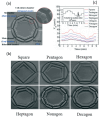Cell Migration Assays and Their Application to Wound Healing Assays-A Critical Review
- PMID: 38930690
- PMCID: PMC11205366
- DOI: 10.3390/mi15060720
Cell Migration Assays and Their Application to Wound Healing Assays-A Critical Review
Abstract
In recent years, cell migration assays (CMAs) have emerged as a tool to study the migration of cells along with their physiological responses under various stimuli, including both mechanical and bio-chemical properties. CMAs are a generic system in that they support various biological applications, such as wound healing assays. In this paper, we review the development of the CMA in the context of its application to wound healing assays. As such, the wound healing assay will be used to derive the requirements on CMAs. This paper will provide a comprehensive and critical review of the development of CMAs along with their application to wound healing assays. One salient feature of our methodology in this paper is the application of the so-called design thinking; namely we define the requirements of CMAs first and then take them as a benchmark for various developments of CMAs in the literature. The state-of-the-art CMAs are compared with this benchmark to derive the knowledge and technological gap with CMAs in the literature. We will also discuss future research directions for the CMA together with its application to wound healing assays.
Keywords: cell migration assay; system and design perspective; wound healing assay.
Conflict of interest statement
The authors declare no conflicts of interest in this work.
Figures





References
-
- Junaid A., Mashaghi A., Hankemeier T., Vulto P. An end-user perspective on Organ-on-a-Chip: Assays and usability aspects. Curr. Opin. Biomed. Eng. 2017;1:15–22. doi: 10.1016/j.cobme.2017.02.002. - DOI
Publication types
LinkOut - more resources
Full Text Sources
Research Materials
Miscellaneous

